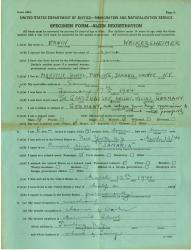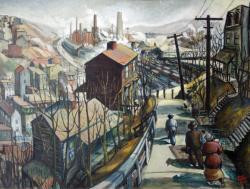Kate Harris
Social Studies teacher
Pittsburgh CAPA
Middle School (13 to 15 years old), High School (16 to 18 years old)
Teacher/Educator
Language Arts And English, Civics, Literature, Cultures, Economics, Social Studies, Geography, Writing, US History, Arts, Other
I'm a history-lover, art fan, and bookworm. I taught high school history (U.S. History and World Religions) for ten years in North Carolina, teach currently in Pittsburgh, PA, and am working to help teachers make the most of this new resource!
Kate Harris's collections
Forced Removal during Apartheid: Examining Historic Photographs
<p><em>How did apartheid affect the lives of blacks living in Johannesburg in the late 1940s and early 1950s? What was the purpose of forced removal?</em></p><p>This student activity uses the examination of historical photographs as an entry point to learning about the forced removal of blacks from urban areas to townships & homelands under apartheid in South Africa. The images here are all from Sophiatown and Soweto. What details emerge about the life changes that resulted from being moved? What questions remain?</p>
 Kate Harris
Kate Harris
19
WWI Propaganda
<p><u></u>This student activity includes a variety of types of propaganda related to World War I. The United States government took great action when it came to World War I—they helped organize workers, recruit military members, and regulate the economy so that American could have a successful impact on the war. The Committee of Public Information formed by George Creel and other propaganda-producers used advertising techniques from businesses to make appeals to the average citizen and encourage them to make a difference. This assignment will ask you to connect each piece of propaganda to one of four major goals of the U.S. government during the war and to analyze a few specific pieces for author, audience, purpose, and even the medium/form. </p><p>Essential questions include:</p><ul><li>What are the four main goals of the government during World War I?</li><li>Why and how did propaganda creators target specific audiences with their messages?</li><li>What are the effects of changing the medium or form of propaganda on how it might be received?</li></ul><p>Tags: World War I, WWI, selective service, draft, liberty bonds, propaganda, music, Uncle Sam, persuasive writing, cause effect</p>
 Kate Harris
Kate Harris
14
National Parks
This topical collection focuses on the establishment of a national parks system in the United States. Items in the collection can be used to address the following questions:
-What is the difference between "conservation" and "preservation"? Which view towards nature seems to influence our national parks system today?
-In United States history, there is often a tension between progress and protection, or change and tradition. How is that tension reflected in the story of the national parks system? Consider the economic demands of a growing nation and the impulse to make the natural world accessible to all members of U.S. society.
Tags: Parks, environment, conservation, preservation, Muir, Sierra Club, Roosevelt
 Kate Harris
Kate Harris
19
Weikers Family Collection Class Warm-Up
<p>This is a single document with hot spots and questions used to model primary source analysis for a sixth grade class. It is drawn from a collection of archival records and photographs documenting the Weikers family's experience in Nazi Germany and their persistent efforts to seek asylum in the United States. You can find the full collection here:</p><p>https://learninglab.si.edu/collections/weikers-family-collection/zGJCDjyWqouEufnb</p><p>Questions to consider are:</p><p>a. Who are the Weikers?</p><p>b. Where did they live?</p><p>c. When did they live? What can they tell us about this time in history?</p><p>d. How were they affected by Nazi Germany?</p><p>e. What did they feel about the Nazis?</p><p>Tags: Nazi Germany, Holocaust era, primary sources, Pittsburgh</p>
 Kate Harris
Kate Harris
2
The Black Power Movement
<p>Teaching about the Black Power Movement can be challenging, but has rich rewards. Misconceptions about the Black Power Movement abound, but the ability to contrast their strategies and aims with the earlier Civil Rights Movement allows Social Studies teachers to discuss the complex ways that social movements evolve, change, and respond to the times. In addition, a study of the Black Power Movement helps give context for a broader study of the economic and political shifts in the 1970s and 1980s and the rise of identity politics. This teaching collection includes a variety of resources that could be used to teach about the Black Power Movement, organized into sections for:</p><p>-People in the Movement</p><p>-Goals and Strategies of the Movement</p><p>-Teaching Activities</p><p>General guiding questions for this collection include:</p><p>-What were the distinct problems that the Black Power Movement tried to address? Do they remain today?</p><p>-What were the strategies of the Black Power Movement? Do you agree or disagree with these? </p><p>-Why and how do social movements develop and evolve? </p><p>-What defines a successful social movement? Was the Black Power Movement successful?</p><p>- Can a social movement survive beyond the demise of its leadership?</p><p>-What is the role of the arts in promoting the ideals of social movements?</p><p>This is a work-in-progress based on the digitized materials within the Smithsonian Learning Lab's collection--it is not meant to be wholly definitive or authoritative.<br /></p>
 Kate Harris
Kate Harris
31
TRETC Explores the Learning Lab
<p>Let's take a journey to see what the Smithsonian has for you and your students. We will use this as a FRIENDLY challenge, and as a way to explore the types of diverse resources and features found in the Learning Lab.</p>
 Kate Harris
Kate Harris
12
Signs of the Times
This collection includes sixteen signs and posted notices from across the Smithsonian's collections. Use your history detective skills to figure out what you can about the sign--but don't look at the information tab! Can you determine the context for each sign, matching it to a place and decade in United States history? Consider who it might have been aimed at and for what purpose it was used. Be as specific as possible. The first resource models a historian's thinking and questioning process for students to mimic with other signs in the collection. Answers are listed on the last resource.
Tags: historical thinking, questions, review activity
 Kate Harris
Kate Harris
17
Who discovered America?
The question "Who discovered America?" invites a lot of discussion, now that many of us recognize that the simple answer of "Columbus" is not entirely accurate. This collection includes resources to help support student investigation into the answers of these questions:
-What does it mean to "discover" a place?
-How did the first peoples arrive in the Americas?
-What claims to the Vikings and the Chinese have to the discovery of America?
-Should Columbus be celebrated as a hero, villain, or something in between?
There are discussion questions and additional links throughout the collection. Teachers and students are invited to explore the many websites included to further their research.
 Kate Harris
Kate Harris
18
Claim-Support-Question: A Sharecropper's Shack
Using the Project Zero Visible Thinking routine "Claim Support Question," a routine for clarifying truth claims, students will examine a photograph taken by Carl Mydans for the Farm Security Administration. This exercise could be used as a warm up for a lesson about the Great Depression's impact on farmers, sharecropping, or the New Deal.
Tags: Roosevelt, New Deal, Farm Security Administration, Great Depression, tenant farmer, sharecropper, migrant farmer, Okie, Missouri, Oklahoma, Dust Bowl, Resettlement Administration.
 Kate Harris
Kate Harris
4
Pittsburgh Landscape
<p>This collection was prepared for a workshop with Pittsburgh Public School teachers about integrating the visual arts with Social Studies curriculum. It models how to use the claim-support-question visible thinking strategy as well as the use of historic lenses that suggest different questions to ask about a work of art.</p><p><br /><br /></p><p>The content focus of this collection is Pittsburgh during the Great Depression. </p><p><br /><br /></p><p>Tags: Pittsburgh, Great Depression, 1930s, New Deal, steel mills, workers, economy</p>
 Kate Harris
Kate Harris
9
Teaching about Andrew Jackson
This collection includes artifacts, lesson plans, and teaching ideas about Andrew Jackson, including his role in the War of 1812 and his presidency.
 Kate Harris
Kate Harris
32
Fourth of July Celebrations
A topical collection inspired by the Fourth of July holiday. Have a picnic, see some fireworks, and enjoy our nation's independence!
 Kate Harris
Kate Harris
14









